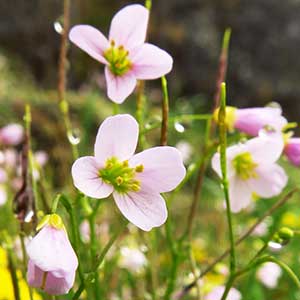Cardamine pattersonii
Cardamine micranthera
Saddle Mountain bitter-cress
streambank bittercress
cylindrical, slender, 0.5–1.5 mm diam.
(relatively short), 2–3 mm diam., (covered with extensive root system).
(simple from base), erect, (not flexuous), unbranched or branched basally, 0.6–3 dm.
erect to ascending, unbranched or branched distally, 0.9–4 dm.
rosulate or not, 3 or 5-foliolate, 1–6 cm, leaflets petiolulate;
petiole 0.4–2.5 cm;
lateral leaflets similar to terminal, considerably smaller;
terminal leaflet (petiolule 0.1–0.4 cm), blade obovate to orbicular or subcordate, 0.3–1.5(–2.0) cm × 2.5–16(–18) mm, base obtuse to rounded or cordate, margins entire or dentate to slightly sinuately lobed.
usually 3-foliolate, rarely simple, 1–8 cm, leaflets petiolulate or subsessile;
petiole 0.5–5 cm;
lateral leaflets subsessile, often minute;
terminal leaflet (petiolule 0.4–2 cm), blade orbicular to broadly ovate, 0.5–3 cm × 5–25 mm, base rounded, margins entire, repand, or dentate.
2–4, 3 or 5-foliolate, blade similar to basal, gradually reduced in size as bract, distalmost ones subtending pedicels of flowers (usually simple);
leaflet blade or bract linear to linear-oblanceolate, 0.2–0.8 cm.
5–10, petiolate;
middle leaves often simple, petiole 0.3–1.5 cm, blade rhombic to suborbicular or ovate, 1–3.5 cm × 6–22 mm, base obtuse to cuneate, margins entire, repand, or dentate;
distal ones with shorter petiole, blade smaller.
bracteate throughout.
ebracteate.
sepals oblong, (2–)3 × 0.7(–1) mm, lateral pair not saccate basally;
petals purple or pink, obovate, 6–9 × 3–4 mm, (not clawed);
filaments: median pairs 3–3.5 mm, lateral pair 2–2.5 mm;
anthers oblong, 0.7–1 mm.
sepals (ascending), oblong, 1.5–2.2 × 0.7–1 mm, lateral pair not saccate basally;
petals (somewhat spreading), white, oblanceolate, 3.5–5 × 1.2–1.8 mm, (not clawed, apex rounded);
filaments: median pairs 2.5–3 mm, lateral pair 2–2.5 mm;
anthers ovate, ca. 0.2 mm.
divaricate-ascending, (10–)15–30(–45) mm.
divaricate, 9–17 mm.
linear, (torulose), 2–3 cm × 1–1.5 mm;
ovules 14–20 per ovary;
style 2–4 mm.
linear, 0.8–1.6 cm × 0.8–1 mm;
ovules 16–22 per ovary;
style 1.2–1.8 mm.
brown, oblong to ovoid, 1.7–2.2 × 1–1.5 mm, (winged distally).
brown, oblong to ovoid, 0.9–1.2 × 0.6–0.8 mm.
Cardamine pattersonii
Cardamine micranthera
Of conservation concern.
Cardamine pattersonii is known from Saddle Mountain and Onion Peak in Clastop County.
(Discussion copyrighted by Flora of North America; reprinted with permission.)
Of conservation concern.
Cardamine micranthera is known only from Stokes County. It is in the Center for Plant Conservation’s National Collection of Endangered Plants.
(Discussion copyrighted by Flora of North America; reprinted with permission.)


